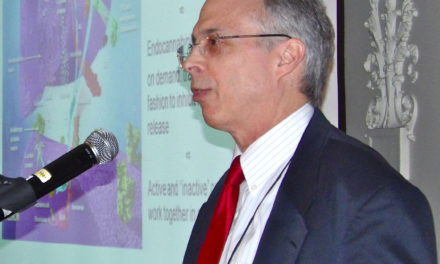The May 5 New Scientist included a piece about Dr. William Brooke O’Shaughnessy by Stephanie Pain. Tod Mikuriya, MD, considered O’Shaughnessy “a personal hero.” Researching his life story was a project Tod never got around to… I wonder if Pain used Michael Aldrich’s essay as a source? She probably didn’t see O’Shaughnessy in India, translated from Bengali to English by Tapoja Chaudhuri, PhD with assistance by Sunil Aggarwal, MD, PhD.
Recognition for W.B. O’Shaughnessy is long, long overdue, but there are some elements missing in Pain’s account. One: the doctors at the hospital in Calcutta where O’Shaughnessy was assigned by the British East India Company had been using cannabis tinctures to treat various conditions and had worked out dosing regimens; so in a general sense, safety had been established long before the Irish-born, Edinburgh-educated WBO arrived. Two: O’Shaughnessy tested cannabis tinctures on himself, as well as on animals —a traditional approach in medical research. Mikuriya did the same when he began studying the effects of marijuana in 1959.
I’m sure he would have appreciated Pain’s piece in the New Scientist, reprinted below with a retro messag:e
ON THE evening of 6 November 1838, William Brooke O’Shaughnessy received an urgent note from the hospital where he worked. Could he come immediately? One of his patients was exhibiting “very peculiar and formidable” symptoms. Alarmed, he rushed to the man’s bedside.
O’Shaughnessy, assistant surgeon with the East India Company’s Bengal Medical Service, had reason to worry. The patient was one of the first human guinea pigs in his pioneering experiments with cannabis. A few hours earlier, the man had been given a modest dose of cannabis resin dissolved in alcohol. What might have gone wrong?
To a scientifically inclined physician based in India, cannabis – or Indian hemp – was a prime candidate for investigation. It was popular as a means of intoxication, but local doctors also valued it as a treatment for a range of ailments. In 1813, one of O’Shaughnessy’s predecessors reported somewhat sniffily on the intemperate habits of those who indulged in the various preparations. But O’Shaughnessy believed cannabis would make a useful addition to Western medicine and decided to put it to the test.
O’Shaughnessy wasn’t just a doctor: he was also a skilled analytical chemist with a modern approach to medical research. He had made a big impression with his meticulous analyses of blood and excreta from people with cholera during an outbreak in England in 1831. He showed that patients were dangerously dehydrated and that bloodletting – then standard treatment – did more harm than good. Two years later, O’Shaughnessy landed a job with the East India Company and set sail for Calcutta.
For millennia, cannabis had been used as a medicine from Egypt to India and China. It had been a traditional remedy in Europe, too, but was hurriedly dropped after Pope Innocent VIII condemned it in 1484 as “an unholy sacrament”. By the 19th century, cannabis was largely forgotten in the West.
O’Shaughnessy began by familiarising himself with the plant. As a narcotic, it was “the ready agent of a pleasing intoxication”, he reported. Dried leaves – known as bang – were smoked, added to peppery drinks or boiled with milk and sugar to make sweets called majoon. Gunjah, made from the resinous flower buds, was mixed with tobacco and smoked. Most potent and costly was the resin scraped from the plant, known as churrus.
O’Shaughnessy also studied ancient texts and consulted scholars and doctors about the use of cannabis in traditional medicine. But if he was to experiment on humans, he needed to show that it was safe and gauge the right dose. So he began with stray dogs – followed by cats, goats and even fish, vultures and storks. Some animals became helplessly intoxicated, others hardly at all. Crucially, none died and even those on the highest doses recovered with no apparent harm done.
The first three humans he gave the drug to had rheumatism. Early on the afternoon of 6 November, each received their dose of resin. It had no apparent effect on two of them, but the third grew “very talkative, was singing songs, calling loudly for an extra supply of food, and declaring himself in perfect health”. After two noisy hours, he fell asleep, just as the other two had. All seemed well. Then came the message.
O’Shaughnessy returned to find his patient “quite insensible”. Then things got a little weird. He lifted the man’s arm, then let go… instead of dropping, it stayed put. Curious, O’Shaughnessy moved his other limbs. “A waxen figure could not be more pliant or more stationary in each position, no matter how contrary to the natural influence of gravity on the part,” he later wrote. The drug had induced a rare nervous condition called catalepsy.
The fuss around the “pliant man” woke one of the other men, who began laughing uncontrollably. The third slept on, apparently unaffected: further inquiries revealed that he was a regular cannabis smoker. The next day, all three “were not only uninjured by the narcotic, but much relieved of their rheumatism”, noted O’Shaughnessy. They were discharged “quite cured” three days later.
Pleased with the results, O’Shaughnessy expanded his trials to other diseases – cholera, tetanus, even rabies. He knew there was no saving the patient with rabies, but with frequent doses of cannabis “the awful malady was stripped of its horrors”. In cholera patients, cannabis stopped the sickness and diarrhoea that left them dangerously dehydrated, allowing them to recover.
But the most dramatic results were in cases of tetanus, a disease characterised by muscle spasms powerful enough to break bones and trigger heart attacks – and almost invariably fatal. Cannabis relaxed muscles and prevented the spasms. Almost miraculously, many people recovered. The results, O’Shaughnessy wrote, “seem unequivocally to show that when given boldly and in large doses the resin of hemp is capable of arresting effectually the progress of this formidable disease”.
Cannabis was catapulted into mainstream Western medicine in 1842 when O’Shaughnessy’s results appeared in the Provincial Medical Journal, forerunner of the British Medical Journal. He was in London at the time – with a considerable supply of gunjah. His paper caused huge excitement; at meetings and lectures he was mobbed by doctors keen to explore this potential wonder drug. O’Shaughnessy’s plan had always been to convince the medical establishment to delve deeper into the plant’s potential and, job done, he returned to India in 1844.
Almost immediately, doctors including John Russell Reynolds, personal physician to Queen Victoria, began to experiment and found cannabis effective in treating migraine and epilepsy. It eased nerve and muscle pain and was effective in treating spasms and convulsions.
By 1850, cannabis was listed in pharmacopoeias in Britain, the rest of Europe and the US. In 1890, Reynolds was able to write in The Lancet that cannabis was “one of the most valuable medicines we possess”. It was also a key ingredient in an array of popular patent medicines, from tonics to corn plasters.
Cannabis remained popular as a medicine for half a century. When it eventually fell out of favour, it was for practical rather than moral reasons. Cannabis wasn’t soluble in water, so unlike other drugs it couldn’t be injected with the newfangled hypodermic syringe. Quality control was an issue: the active compounds had yet to be isolated, and plant extracts were notoriously variable. Synthetic drugs were the future. Medicinal cannabis lingered on into the 20th century until it was eventually finished off by anti-narcotic campaigns and increasingly tough legislation.
But the research started by O’Shaughnessy never stopped entirely. The identification of a key active ingredient, tetrahydrocannabinol, in 1964 was followed in the 1990s by the revelation that the human body makes its own cannabinoids. We are now in a new phase of investigation with a push to develop synthetic cannabis-like drugs. O’Shaughnessy would have approved.
This article appeared in print under the headline “High expectations”
Stephanie Pain is a writer based in Brighton, UK (who has probably heard enough stupid wordplay in her day).
O’S Retro message: Almost as a throwaway line, Pain attributes more than 500 years of Cannabis prohibition to Pope Innocent VIII’s papal bull condemning use of the herb in 1484 as “an unholy sacrament.” Papal infallibility is forever, and here we are today… Have you noticed that rightwing edicts never really disappear?
According to Encyclopedia Britannica, Innocent VIII tried unsuccessfully to launch a crusade against the Muslims. Was he playing the Hashish card in his Bull?
I found Innocent’s “Summis Desiderantes” online, but didn’t see a reference to cannabis use. The pope is telling the inquisitors to wage war on all forms of sorcery and witchcraft. Pot smokers may have qualified automatically.
“It has recently come to our ears, not without great pain to us, that in some parts of upper Germany, as well as in the provinces, cities, territories, regions, and dioceses of Mainz, Koin, Trier, Salzburg, and Bremen, many persons of both sexes, heedless of their own salvation and forsaking the catholic faith , give themselves over to devils male and female, and by their incantations, charms, and conjurings, and by other abominable superstitions and sortileges, offences, crimes, and misdeeds, ruin and cause to perish the offspring of women…”
The inquisitors were not very selective in who they went after. Their real motivation, according to Helen Ellerbe’s Dark Side of Christian History, was asset forfeiture!
Sortilege (noun): the practice of foretelling the future from a card or other item drawn at random from a collection.






